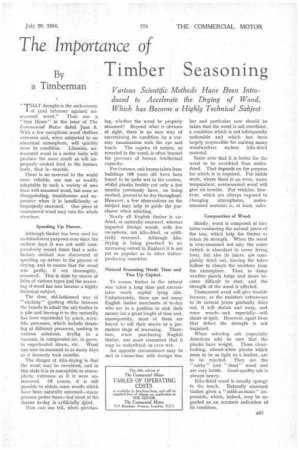The Importance of
Page 49

If you've noticed an error in this article please click here to report it so we can fix it.
By Timber Seasoning a Timberm an. Various Scientific Methods Have Been Intro
duced to Accelerate the Drying of Wood, Which has Become a Highly Technical Subject
" THAT drought is the arch-enemy
I of (and informer against) unseasoned wood." Thus ran a. "One Hears" in the issue of The Commercial Motor dated June 8. With a few exceptions wood dislikes extremes and, when subjected to an abnormal atmosphere, will quickly show its condition. Likewise, unseasoned wood in a motor body will produce the same result as will improperly cooked food in the human body, that is—trouble.
There is no material in the world more reliable, nor one so readily adaptable to such a varietyof uses than well-seasoned wood, but none so disappointing, troublesome and expensive when it is insufficiently or improperly seasoned. One piece of unseasoned wood may ruin the whole structure.
Speeding Up Nature.
Although timber has been used for multitudinous purposes ever since the earliest days it was not until comparatively recent times that a satisfactory method was discovered of speeding up nature in the process of drying, and to ensure that the wood was partly, if not thoroughly, seasoned. This is done by mean S of kilns of various types and the seasoning of wood has now become a highly technical subject.
The slow, old-fashioned way of " sticking " (putting sticks between the boards to admit the air) timber in a pile and leaving it to dry naturally has been superseded by quick, scientific processes, which -include steaming at different pressures, soaking in various solutions, dryitig in a vacuum, in compressed air, in gases, in superheated steam, etc. Wood can now be seasoned in as many days as it formerly took months.
The danger of kiln-drying is that the wood may be overdried, and in this state it is as.susceptible to atmospheric extremes as if it were unseasoned. Of course, it is still possible to obtain some woods which have been naturally seasoned—many persons prefer them—but most of the timber to-day is artificially qiied.
How can one tell, when pUrchas
lug, whether the wood be properAy seasoned? Beyond what is obvious at sight, there is no sure way of ascertaining its condition by a cursory examination with the eye and touch. The caprice of nature, as revealed in the wood, is often beyond the province of human intellectual capacity.
For instance, oak beams taken from buildings 100 years old have been found to be quite wet in the centres, whilst planks freshly cut only a few months previously have, on being worked, proved to be dry throughont. However, a few observations on the subject may help to guide the purchaser when selecting.
Nearly all English timber is airdried, or naturally seasoned, whereas imported foreign woods, with few exceptions, are kiln-dried, or artificially seasoned. Although kilndrying is being practised to an increasing extent in England it is not yet so popular as in other timberproducing countries.
Natural Seasoning Needs Time and Ties. Up Capital.
To season timber in the natural way takes a long time and necessitates much capital lying idle. Unfortunately, there are not many English timber merchants of to-day who are in a position to sink their money for a great length of time and, consequently, most of them are forced to sell their stocks at a premature stage of seasoning. Therefore, when purchasing English timber, one must remember that it may be underdried, or even wet.
An opposite circumstance may be met in connection with foreign tim her and' particular care should be taken that the wood is not overdried, a condition which is not infrequently noticeable and which has been largely responsible for making many woodworkers eschew kiln-dried material.
Some aver that it is better for the wood to be overdried than underdried. That depends on the purpose for which it is required. For inside work, where there is an even, warm temperature, overseasoned wood will give no trouble. For vehicles, however, which are always exposed to changing atmospheres, underseasoned material is, at least, safer.
Composition of Wood.
Briefly, wood is composed of tiny tubes containing the natural juices of the tree, which help the timber to retain its strength. When the wood is over-seasoned not only the water (which is abundant in every living tree), but also its juices, are completely dried out, leaving the tubes hollow to absorb the moisture from the atmosphere. Thus, in damp weather panels bulge and doors become difficult to shut, and the strength of the Wood is 'affected.
Unseasoned wood will give trouble because, as the moisture extraneous to its natural juices gradually dries out, it will shrink and warp, and some woods—oak especially—will shake or split. However, apart from that defect the strength is not impaired.
When selecting ash (especially American ash) be sure that the planks have weight. Those "cleanlooking, almost-white planks which seera to be as light as a feather, are to be rejected. They are the " corky "and "dead-" wood and are very brittle. Good-quality ash is always heavy.
Kiln-dried wood is usually spongy to the touch. Naturally seasoned timber gives a " solid-as-stone " ire.press2M, which, indeed, may be rip, garded as an accurate indication ot its condition.




























































































